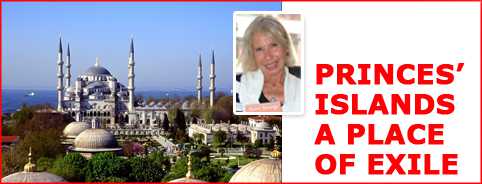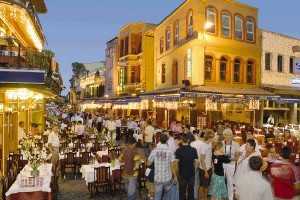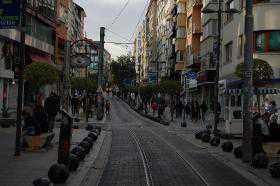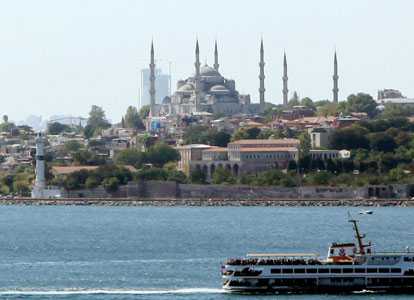DIDIM -based Inka Piegsa-Quischotte, an ex-attorney turned online travel magazine writer and novelist, continues her adventures around Istanbul. You can now catch up with Inka on her travels via her new websiote: www.glamourgrannytravels.com
I have visited Istanbul on several occasions, but I never got around to embark on a day trip to the Princes’ Islands.
I really tired of my Turkish friends telling me off for having missed: ‘a small paradise, beautiful nature, steeped in history, sooo romantic…’ you name it, every attribute is attached to the group of nine islands located in the Sea of Marmaris close to the Asian side of Istanbul.
When I came to visit Istanbul again, I had barely touched down in Atatürk airport and made my way to my favorite hotel in the Sultanahmed district that I went in search of the best way of getting there, ready to see for myself and remedy my reproachable omission.

Naturally, I wanted to know what the Princes’ Islands were named after. A bit of research revealed that during the Byzantine period and later, during the Ottoman Empire, troublesome or otherwise unwanted members of the royal families were shipped off to one of the nine islands, which guaranteed that they were well out of the way, as the islands can only be reached by boat.
In addition, rough weather in winter and spring did not allow for boats to sail to the islands at all, and therefore the exiled royalty were well under control.
Not only princes were sent there but also the Byzantine empresses Irene, Zoe and Anna Dalossena were stashed in a convent on Büyükada, the largest island. In 1929 it was also the first stop in exile for Leon Trotsky, who stayed there for four years.
How to get there
I like to stay in the Sultanahmed district for two reasons: many of Istanbul’s mayor attractions like the Blue Mosque, the Hagia Sofia, Topkapi Palace and Grand Bazaar are within walking distance, and it’s a stop along my preferred means of transport: the #38 streetcar. It runs from Zeytinburnu to Kabatas over the Galata Bridge and costs all of TL 2 ($1 = approx. TL 1.5).
Take the streetcar to the last stop, Kabatas, then cross the street (use the underpass!) towards the sea and you will see the ticket counter of the Turkish Ferry Service IDO. The round-trip fare for the Princes’ Islands is TL6. You don’t need to go on an organized trip, for very little money you can easily arrange your own island adventure.
The crossing
The ferry is no tourist cruise but the means of transportation for people living on the islands or those who want to visit. This means that the boat trip as such is already a lively experience. Tourists mingle with locals, food is shared, questions are asked and the 90-minute crossing is pure entertainment.
The ferry stops at three or four of the nine islands as needed by the passengers and the views as the minarets of Istanbul recede into the distance and smaller uninhabited islands glide by, are stunning. You are, of course, on the open sea and the crossing can get rough, but I was lucky.
What to do and to see
No cars, except some service vehicles, are allowed on any of the islands. Which leaves three means of getting around: your feet, bicycles you can rent, and, most famous, horse-drawn carriages.
I went to Heybeliada the second largest island and then on to Büyükda, the largest.
Getting off the ferry, I wanted to experience the horse carriage romance. I met a lovely couple from Malaysia on the ferry, and we decided to share one.
The trick is to disembark, turn left, bypass the tourist groups who walk straight up the hill and find the “horse carriage rank” on your own. The big tour costs TL50 and soon we were happily on our way waving at the jostling crowd as we clip clopped by.
The absence of cars means clean air and silence. The islands are hilly and heavily wooded and the road leads along some fascinating wooden Victorian houses, masterpieces of architecture, which were built in the 19th century when the islands became a fashionable resort for wealthy people from Istanbul.
The funny thing is that there seems to be a sort of competition among the carriage drivers and they really make their horses run and overtake each other. Much as I tried, I couldn’t persuade the driver to stop along the way and let me take more pictures of the houses, but then, the roads are narrow and he would have caused a traffic jam.
Finally, he let us get off at the top of the hill in the middle of a wonderful forest where some locals sat by the wayside making flower wraths. The perfume of pine trees and wild flowers is everywhere in the air and the word ‘nature paradise’ is truly justified.
You have a choice between a ‘small’ tour which ends here at the Luna Park or the ‘big’ tour which returns you to the jetty.
If you decide to stop here, the next means of transport is waiting: baying donkeys which you can mount and ride further up the mountain to a famous 11th century monastery.
We decided to return, downhill to the jetty and have a bite to eat. Restaurants line the port area, but we meandered through side streets and had lunch in one of the ‘holes in the wall’ where you can choose from a hot or cold buffet and the food is prepared before your eyes.
My friends then hired bicycles and made another tour under pedal power, but I returned to Istanbul because I had another treat in mind.
Over and under the Galata Bridge
Back in Kabatas I took the streetcar in the opposite direction and got off after two stops at Eminönü. Then I walked over the Galata Bridge which is teaming with fishermen. The fish they catch is either for themselves, or sold at the other end as one of Istanbul’s most famous snacks: the fish buns.
Fillets of fish are grilled and prepared in floating kitchens, slapped into a hot bun, decorated with pickles by costumed vendors and eaten on the go. Delicious and a very colorful event.
It’s also a treat to climb down the stairs and walk along the promenade under the bridge very close to the water’s edge. Ferries churn by and you can enjoy a coffee or tea in one of the many cafes.
When to go
In the off season, the biggest island has a population of about 3000. During the summer months, it’s a very popular Sunday trip for the people of Istanbul, not to mention the thousands of tourists who visit every day.
It can get crowded, so it’s best to visit and enjoy a wonderful day trip in March, April or May.




